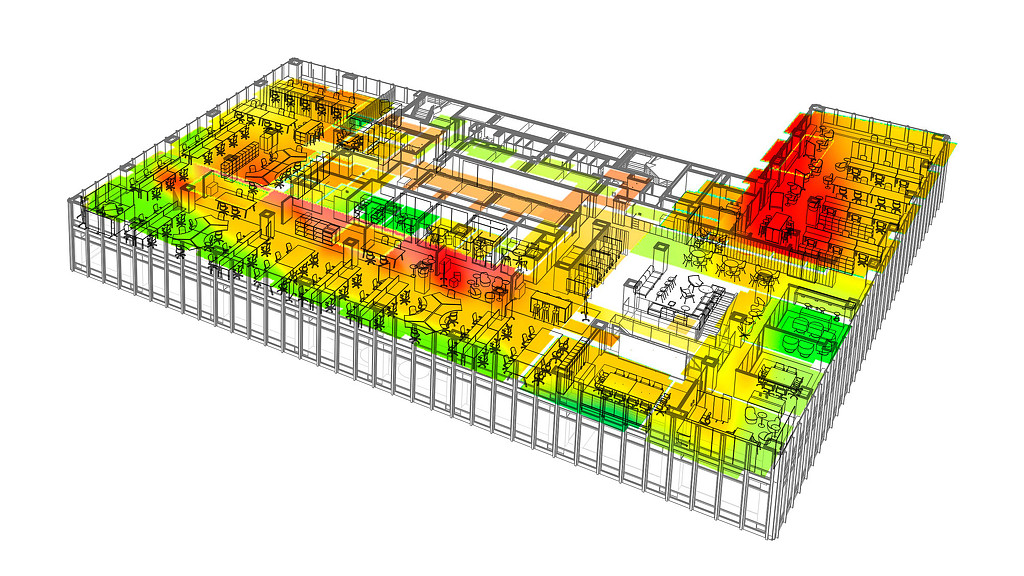Creating Data-Rich Workplaces to Detect and Curb Viral Transmission
April 15, 2020 | By Richard Tyson
Editor’s Note: This post is part of our ongoing exploration of how design is responding to the COVID-19 pandemic.
While we live in a connected global community made up of smart cities and spaces powered by data and digital technology, the COVID-19 pandemic has revealed gaps in what we know. This is especially true in the workplace where health and wellness is at the forefront of everyone’s mind as we think about how to return to the office.
We don’t know who in our office or building might be a health risk, for example. We can’t be sure that the air is being circulated frequently. And we have no way of knowing if visitors have traveled to infected or at-risk zones.
Because of this gap in our knowledge, it’s difficult to inspire a sense of trust and safety for the people who use the places and space we create.
The good news is that employers can use data and technology in the workplace to fill in the gaps. We have the ability to monitor health and detect risks, implement new virtual ways of connecting, measure the adoption of healthy habits, and ultimately inform stronger decision-making to protect people.
Using data to identify risks and track patterns
Using data to better understand and track health patterns has already been happening on a larger scale. Anyone can monitor Google Search Trends to track infection rates in various geographic locations. Google has also launched a coronavirus information portal while Apple has updated its Siri assistant to field questions about the coronavirus and point people towards resources. These two tech giants also recently announced a joint effort focused on contact tracing that would enable the use of Bluetooth technology to help government and health agencies track the spread of COVID-19.
In the future, we can also plan to build our knowledge base by optimizing our physical spaces to help protect people from viral transmission. For example, in the workplace, employers could install Infrared Fever Screening Systems (IFSS) at entry points to detect if an employee or visitor has a fever. Sensor technology could also be employed to monitor symptoms.
In fact, sensor and data collection can map patterns of adoption rates of healthy habits, strategically optimize floorplans, and measure the success of virtual tools to allow for physical distancing. Employers should also plan to provide workers with a centralized portal where they can access health data, updated policies, and relevant health and travel advisories. We are entering a time of unprecedented ability to capture and compile data about human behavior, and we know this can be concerning to some. Gensler is committed to the ethical collection and use of data and whenever possible avoid collecting personally identifiable information.
In today’s rapidly changing world, whether it’s the coronavirus, market changes, or new workstyles that must be supported by the same workplace, employers must be asking how they can learn and adapt quickly. Right now, the focus is on the healthy workplace, and data can help inform how organizations should be adapting to a new reality that includes viral threats.
Here are a few ideas for how data can inform a healthier workplace:
Designing a healthy workplace is no longer simply about designing open staircases to encourage movement that boosts wellness and productivity, but rather, it’s about design interventions focused on viral transmission risk. This might include understanding flows and pinchpoints, smart materials that notify when things have been touched but not cleaned, automation and voice activation tools that limit touchpoints like door handles, and advanced air purification systems that reduce airborne contaminants.
2. Use virtual working habits and technologies to remake the officeEmployees are now working from home and discovering new shared platforms and communicative tools that they’ll likely take back to the office. This remote working experience is an opportunity to investigate and collect data on emerging behavioral patterns of collaboration and consider how we can translate them to physical spaces.
The relationship between remote, or virtual space, and real, or physical space, is organically shifting, and this can alter the centralization of communications, for instance, or inform new floorplan designs.
Understanding how employers’ policies and practices, team dynamics, and individual productivity, are actively being rebalanced by the need to work remotely can require learning new muscles. We can use data to learn about new habits, software, and workstyles now, and consider how this will impact companies’ real estate, IT and infrastructure, human resources and policies, and health and wellness.
3. Wire the built environment to understand behavioral patternsThe built environment is changing its meaning: in a viral situation the design principle is different, and we need to collect different data about shared spaces. For instance, calculating per square foot density doesn’t provide much insight into how healthy a population is during a time when we’re practicing physical distancing, but statistics on frequency and duration of handwashing in the office might be useful.
A workspace is no longer just real estate. It’s critical for developers, building owners, and employers to set up workplaces to be environments that offer the opportunity to learn about behavior so that they can bend the curve towards positive outcomes, including a healthier workplace.
4. Design for experimentation in workplace floorplansIn the long-term, the next frontier in workplace design will emphasize building better systems of understanding into corporate real estate in order to learn more about the space itself and how people use it.
We believe companies should deliberately set aside a percentage of square footage to be experimental and prepared for learning what a new behavior needs to be, then simulate and test for that with responsive preparedness in mind. This is how we can de-risk a million square feet.
At Gensler’s New York office, for example, we’ve dedicated an entire floor to essentially act as a living lab where our team tests sensor technologies to ensure the data we’re collecting is reliable. We use multiple kinds of sensing including occupancy sensing, and we’ve developed our own computer vision sensing that is GDPR-compliant to understand flow in the built environment.
COVID-19 is a wakeup call that’s disrupting everything from workstyles to information systems to supply chains. It’s a call to action for how we need to think about designing for resilience, not just in terms of sustainability, but rather, as the ability to withstand, adapt to, and recover from sudden shocks. But to do this effectively, we must have a way to measure what we’re trying to achieve, so we can design that intention into the built environment. Now is the time to create the future wellbeing of our workplaces and our people.
For media inquiries, email .

